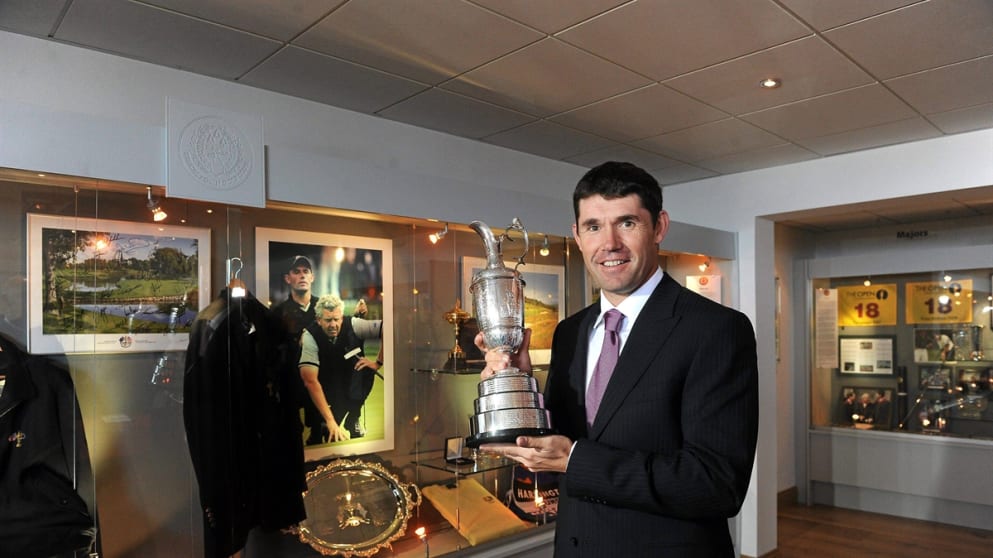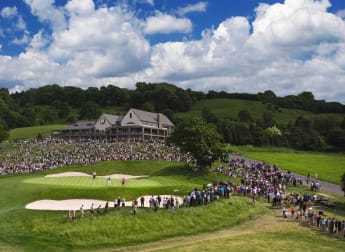Even the most accomplished players can be powerless against the might of golf’s handicap system. This may explain why Padraig Harrington never won a net prize at Stackstown Golf Club before his departure into the professional ranks in the autumn of 1995, as a double Irish champion playing off plus-2.

Any shortage of domestic mementos from amateur days, however, have been more than offset by Harrington’s achievements outside Stackstown. And an extensive representation of his formidable haul will be on display in the clubhouse from Wednesday of this week, when the player formally opens the “Harrington Room.”
On driving into the club, which nestles on a hilly perch in west Dublin, there is immediate evidence of pride in a local hero. The gable-end of the clubhouse proclaims: “Stackstown Golf Club. Proud of our three times major champion Padraig Harrington.”
Inside, visitors will find a committee room, which has been transformed into an Aladdin’s Cave of golf memorabilia, covering all the key aspects of the player’s career. There is a display cabinet representing his amateur days and another one specifically for three Walker Cup appearances, including a significant role in the 1995 victory at Royal Porthcawl.
Further along a special unit contains mementos from Harrington’s World Cup victory with Paul McGinley at Kiawah Island in 1997 and six Ryder Cup appearances, dominated by the record-breaking triumph at Oakland Hills in 2004. An alcove is devoted to his three major championship victories before moving on to the final unit marking regular tournament wins on five continents.
The display, which includes blazers, crystal and trophy replicas, has been more than a year in the making. Indeed, I can recall visiting Harrington in his house in south Dublin early last year when the idea of the room began to take shape. Looking back through his career at that stage, there were events to which he attributed surprising importance and others he had curiously overlooked.
Either way, gathering the stuff, much of it from his parents’ home in Rathfarnham, would be the real challenge. Some items he would probably have preferred to forget, like copies of the 54-hole scorecards, which gave him a five-stroke lead in the Benson and Hedges International at The Belfry in 2001. That was when he was disqualified on the morning of the final day after it had been discovered he failed to sign his first-round card.
The room wouldn’t exist, of course, but for the chain of extraordinary events that began in the late afternoon of July 22, 2007. That was when the television camera’s intrusive eye picked up every wince and wobble of a decent, dignified man being stripped bare before Carnoustie and the world.
Yet the disturbing, unremitting trauma of the 72nd hole, where he twice found the Barry Burn’s waters, was the price Harrington had to pay in pursuit of the 136th Open. And while the 2008 staging at Royal Birkdale was, in sharp contrast, total dominance, his PGA Championship triumph at Oakland Hills three weeks later, also had anxious moments.
His most significant, early memory of Stackstown concerns an occasion when sharp, autumn winds swept down from the Dublin Mountains on the 700 spectators gathered for the official opening of the club. It was September 1983 and an eager, young face in the crowd was that of a 12-year-old lad with a shock of black hair. By his own admission, he had little interest in legendary golf figures Christy O’Connor Sr. and Peter Thomson plying their craft for the pleasure of the assembled throng. He was captivated simply by the excitement of the occasion.
Even into his teen years, there were no golf posters on his bedroom walls; no images of idols such as Seve Ballesteros or Nick Faldo, who inspired so many of his generation. Back then, he was more interested in his peers, the rivals he was trying to beat in the various amateur tournaments of the time. For instance, his hero of 1989 was Scotland’s Colin Fraser, who beat him at number one in the Boys’ Internationals at Nairn.
Those experiences shaped his career, especially in his patient acceptance of disappointments, some of which were especially painful. So it was that in coping with all his second-place finishes as a professional, he kept telling himself that things would turn around, just as they had done in his amateur days. By his own admission, the toughest amateur defeat came in the final of the Irish Close at Portmarnock in 1994. Two up with three to play against David Higgins,
Harrington eventually lost on the 20th, which he three-putted. By way of comfort, his father, Paddy, said to him afterwards: “There will be better days, son. There will be better days.”
And, of course, there were. Paddy Harrington died in July 2005, two years before his son’s major breakthrough. And one could imagine him taking special pride in the “Harrington Room” at a course which he, himself, helped to shape with pick and shovel, more than 30 years ago.
By Dermot Gilleece, reproduced by kind permission of GlobalGolfPost, March 21 edition




